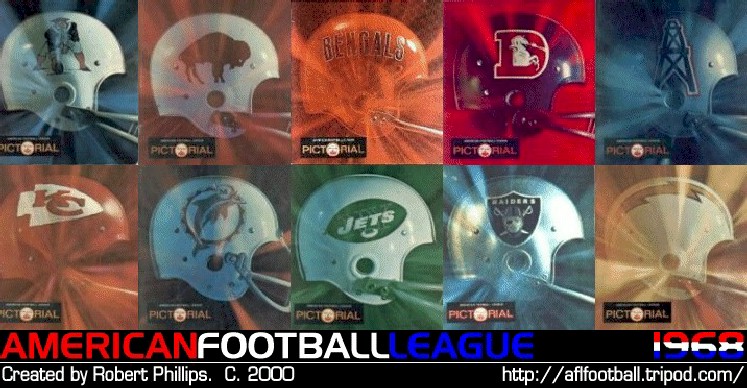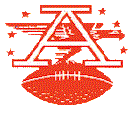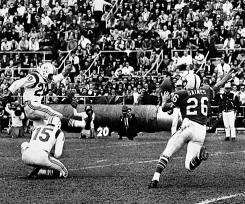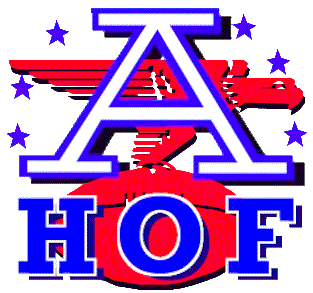|
By Sean Leahy, USA TODAY
First in a series exploring the histories of all 10
AFL franchises as the NFL celebrates the league's 50th
anniversary.
If Mary Sullivan had had her way, the
New England Patriots might never have become a reality.
The wife of Patriots founder Billy
Sullivan had a dream — and a savings account to match — for
a summer home on Massachusetts' Cape Cod. But her husband
persuaded Mary to wait on the Cape home as he and nine
partners invested $25,000 to purchase the start-up American
Football League's final franchise charter in 1959.
It was a humble beginning to a team
that would, more than four decades later, become one of the
NFL's titans. But it made Sullivan, who died in 1998, the
godfather of professional football in New England.
"I can't help but think if he just
drove around Boston to see how many cars have Patriots
stickers on the back," says Sullivan's son, Patrick, the
team's general manager from 1983 to 1991.
"He knew there was an interest in
football in the region. It just needed a little nurturing,
cultivation and excitement."
The Boston Patriots were competitive
in their formative years. They won 35 games from 1961 to
1964 and reached the 1963 AFL title game. Still, the team's
logistics were very challenging, and the Patriots started
off homeless.
The team used four sites — Fenway
Park, Harvard Stadium and fields at Boston College and
Boston University — for home games during the AFL's 10-year
run. Gino Cappelletti, the star wideout and kicker who won
the 1964 league MVP, said being nomads didn't faze the
players. "It was all part of the adversity that the league
and players were going through," he says. "No one really
gave a damn. Let's buckle up those helmets and go out and
play."
Many of the players wouldn't have
been playing professionally if not for the upstart league.
So Cappelletti said it was easy for the Patriots, who also
didn't have a permanent practice field, to accept watching
game film while sitting on milk crates in the bowels of a
high school stadium.
"We hung bed sheets over water
pipes," Cappelletti says, "and we'd show the film against
those sheets."
Initially, drawing fans was a
struggle. When the Patriots launched, the Boston Celtics
were two years into a string of eight consecutive NBA
titles, and the Boston Bruins and Boston Red Sox were well
established.
"The (NFL's New York) Giants were the
big favorites" former Patriots quarterback Babe Parilli
says, "and we were infringing on them."
Adds Cappelletti, "The Giants players
were household names all around New England. … We had to
just hold our own."
The AFL's pass-happy style helped the
Patriots make inroads. In 1960, they averaged 16,894 fans a
game. By 1964, their average attendance rose to 28,522. The
Patriots boasted stars in Cappelletti, 1966 AFL MVP Jim
Nance, who led the league in rushing in 1966 and 1967, and
Parilli, whose 31 touchdown passes in 1964 set a team record
that stood until
Tom Brady's 50 surpassed it in 2007.
In 1964, Cappelletti kicked off a
five-game winning streak by drilling a game-winning field
goal to beat the Houston Oilers 25-24 at home, and Parilli
said that made fans take notice. "They called us the cardiac
kids," Parilli says, "and we started to draw after that."
Offense — and lots of it — was the
game plan for the league. Teams recruited innovative coaches
who would make AFL action distinct from the NFL's
methodical, in-the-trenches style. "The way we were going to
survive was by playing a brand of football that was
exciting," Cappelletti recalls.
It was more fun playing in the
wide-open AFL, says Parilli, who spent five years in the
NFL. Back-and-forth AFL contests that ended 40-38 enthralled
fans, who suddenly saw that not every game needed to end in
a 7-3 defensive battle. "I think that's what the NFL finally
realized, that they needed to get more scoring," Parilli
says. "The fans wanted to see some offense."
Cappelletti's celebrity was enhanced
by his job as a sports anchor on a local TV station — while
he was a player. For a league and a team trying to emerge
from the NFL's shadow, getting free advertising every night
was enough to allow Cappelletti to break curfew at training
camp.
The AFL was not a rich man's game in
its infancy. Many Patriots players worked second jobs. "The
football pay was really not going to do it for you," says
Cappelletti, who earned $7,500 in his first season.
In the league's early days, some
players worried that their clubs couldn't afford to pay
them.
But by the mid-1960s, lucrative
television deals and rising acceptance from fans helped to
pump money and confidence into the start-up league. "I never
really got the sense that this was some sort of second-rate,
novelty thing," Patrick Sullivan says. "Once we developed
our own stars and they became fixtures in the community,
then people said we'd stand up against any teams in the
NFL."
But for the Patriots, less
well-heeled than their AFL competitors, administrative
challenges remained.
"We really didn't know whether we'd
play at Fenway, BC or Harvard," Sullivan says. "So we
printed tickets for all three venues to send to season
ticketholders."
But the struggles of the AFL founders
paid off. The fans won, with pro football entrenched in
cities that the NFL had been underserving. The players won,
with new life for those who would otherwise have seen their
football dreams die. And the "Foolish Club" — the moniker
given to the AFL owners — won by disproving doubters when
the once-fledgling league won acceptance from the NFL.
"We were all struggling and trying to
buck the establishment and trying to survive another day and
another season," Cappelletti says. "It's something that we
probably look back on and realize the difficulties we had
that we just didn't know about at the time. When you're
pioneering, you don't really know it because everything is
exploring."
And Mary Sullivan won when she
finally got the summer house on Cape Cod. She still lives
there, with a keepsake of the AFL's rise cherished by her
late husband: A photo of Billy Sullivan and his fellow
owners taken 45 years ago as the league began to turn the
corner. The inscription on the frame around the AFL logo
reads: "The Foolish Club, Age 5."
Mary Sullivan can relish that this
year as the NFL again toasts the Foolish Club, age 50. |


















